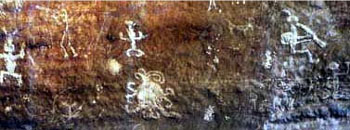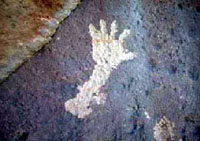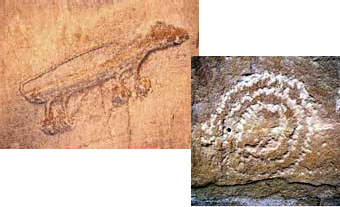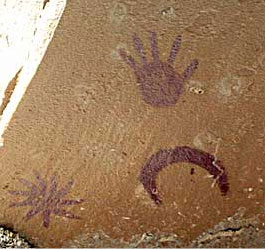 Chaco Canyon abounds in rock art, images made on rock surfaces. Spirals, figures, animals, and other designs can be found at Chaco and throughout the American Southwest, probably serving to mark events, to designate clans and migrations, and as reminders of stories and ceremonies. Images made by pecking or scraping into rock are called petroglyphs; those made by painting pigments on the rock are called pictographs.
Chaco Canyon abounds in rock art, images made on rock surfaces. Spirals, figures, animals, and other designs can be found at Chaco and throughout the American Southwest, probably serving to mark events, to designate clans and migrations, and as reminders of stories and ceremonies. Images made by pecking or scraping into rock are called petroglyphs; those made by painting pigments on the rock are called pictographs.
 Archaeologists seeking to establish when rock art was made use a variety of techniques, none of which is infallible.
Archaeologists seeking to establish when rock art was made use a variety of techniques, none of which is infallible.
If there are other structures or artifacts nearby, the age of rock art can be estimated by association. This technique applies at Chaco Canyon, where rock art is presumed to date to the construction and occupation of the nearby
Great Houses
, established by tree-ring dating to be from AD 850 to AD 1150. Likewise, patterns or symbols on rock art can be matched to similar patterns on pottery or weavings of known age.
 Archeologists can also date
petroglyphs
by studying rock varnish, a patina of iron and manganese oxides that collect on the surface of rock over time. Scraping or pecking a petroglyph removes the thin outer layer of rock varnish, exposing "fresh" rock beneath. Over time, this exposed rock slowly develops a patina of its own. An experienced eye can estimate the age of a petroglyph just by the darkness of the returning rock varnish. Researchers are also developing methods to date petroglyphs by directly measuring the thickness of the rock-varnish layer. Some oppose these efforts, however, because they involve removing small bits of rock from the petroglyph, inflicting irreversible damage.
Archeologists can also date
petroglyphs
by studying rock varnish, a patina of iron and manganese oxides that collect on the surface of rock over time. Scraping or pecking a petroglyph removes the thin outer layer of rock varnish, exposing "fresh" rock beneath. Over time, this exposed rock slowly develops a patina of its own. An experienced eye can estimate the age of a petroglyph just by the darkness of the returning rock varnish. Researchers are also developing methods to date petroglyphs by directly measuring the thickness of the rock-varnish layer. Some oppose these efforts, however, because they involve removing small bits of rock from the petroglyph, inflicting irreversible damage.
 Pictographs
are sometimes dated using the naturally occurring
isotope
carbon-14 (carbon-14 is an isotope of ordinary carbon, carbon-12 ). Found in organic matter of all kinds—including the blood, egg, or oils used to bind pictograph pigments—the proportion of carbon-14 in a plant or animal diminishes predictably over time once the organism dies. Measurements of the remaining carbon-14 give an estimate of age. However, using carbon-14 dating to date petroglyphs is tricky and controversial. Often, samples are contaminated with data-distorting newer organic material that has settled or grown on the rock. Also, carbon-14 dating is destructive; it requires removing a piece of the pictograph to use as a sample.
Pictographs
are sometimes dated using the naturally occurring
isotope
carbon-14 (carbon-14 is an isotope of ordinary carbon, carbon-12 ). Found in organic matter of all kinds—including the blood, egg, or oils used to bind pictograph pigments—the proportion of carbon-14 in a plant or animal diminishes predictably over time once the organism dies. Measurements of the remaining carbon-14 give an estimate of age. However, using carbon-14 dating to date petroglyphs is tricky and controversial. Often, samples are contaminated with data-distorting newer organic material that has settled or grown on the rock. Also, carbon-14 dating is destructive; it requires removing a piece of the pictograph to use as a sample.

 Chaco Canyon abounds in rock art, images made on rock surfaces. Spirals, figures, animals, and other designs can be found at Chaco and throughout the American Southwest, probably serving to mark events, to designate clans and migrations, and as reminders of stories and ceremonies. Images made by pecking or scraping into rock are called petroglyphs; those made by painting pigments on the rock are called pictographs.
Chaco Canyon abounds in rock art, images made on rock surfaces. Spirals, figures, animals, and other designs can be found at Chaco and throughout the American Southwest, probably serving to mark events, to designate clans and migrations, and as reminders of stories and ceremonies. Images made by pecking or scraping into rock are called petroglyphs; those made by painting pigments on the rock are called pictographs.
 Archaeologists seeking to establish when rock art was made use a variety of techniques, none of which is infallible.
Archaeologists seeking to establish when rock art was made use a variety of techniques, none of which is infallible.
 Archeologists can also date
Archeologists can also date
